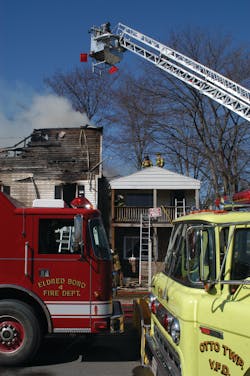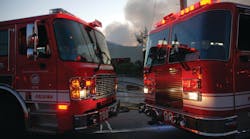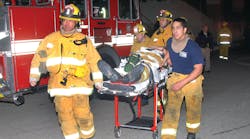20 Tough Questions For the Fire Chief: Are You Prepared To Answer Them? Question 11
In many communities, the number of structure fires has been trending downward. The reduction in these fire responses can be attributed to many factors, not the least being effective fire prevention programs, active inspection programs and aggressive code enforcement – the proactive efforts many fire departments use to prevent the occurrence of fire. While some may argue that better designs and detection and suppression systems have contributed to a reduction in fire responses, this is not accurate. While early detection and early suppression improve victim survivability and reduce fire losses, the fire department still responds.
The central question is: When does the number of fire responses become low enough to consider consolidating or contracting with another community for fire protection? The core issue of this inquiry may not be one of quantity. Rather, it may be one of quality. When looking to consolidate or contract with another community, the elected and appointed officials should first and foremost give consideration to what impact that will have on the level of service the residents and businesses receive post-contract or post-consolidation.
Assessing risks
Before evaluating the impact of contracting or consolidating, elected and appointed officials should first establish the acceptable level of service – or standards of coverage – for the community. While the number of fires may be declining, they are not being eliminated. It is important to keep in mind the residents or businesses that do have a fire are not going to be concerned with the downward trend in overall fire responses when their home or business is on fire. They are going to expect, and deserve, a prompt and effective response and resolution to their emergency.
Thus, it all boils down to finances and risk management: How much risk a community is exposed to and how much money a community can afford to expend to reduce the level of risk exposure. Where funding is not a concern (and yes, there are a few pocketed areas around the country that seem to have been immune from the impact of the economic downturn), the elected and appointed officials may be comfortable with funding a fire department to a level that ensures a prompt and effective response to all emergency calls, even where the overall number of actual fires has been declining.
In communities where finances have been hard-hit, all services have been subject to review and tough decisions are at hand. For the fire department, that means asking: At what point does the combination of reduced fires and economic hardship compel a community to consolidate services or contract for services?
There is no formula for figuring this out. There are benchmarks that can be used for comparison (e.g., calls per resident, the cost of fire protection per capita and the incremental cost of a fire call response per capita). However, a word of caution is necessary here. Ratios and statistics are just one component to be used in the decision-making process and, arguably, may not be the best. For example, one community’s cost-per-call may be $1,300 while the neighboring community’s cost-per-call is only $700.
These are the kind of numbers that can make elected officials set up and take notice. The numbers don’t lie, right? Or do they? We are reminded of a quote by British Prime Minister Benjamin Disraeli (later popularized in the U.S. by Mark Twain): “There are lies, damned lies and statistics.” What was meant by that is statistics, taken out of context or with a certain “spin” added to them, can be made to say just about anything. For example, if it is determined that a fire department’s average cost per call is $1,300, it may be assumed that half the calls for service cost more than $1,300 and half the calls for service cost less than $1,300, where, in fact, a closer look may reveal that 99% of the calls may have cost $500 per call and 1% of the calls for service cost over $20,000.
What the statistics say
Clearly, statistics do not tell the whole story. Yet, elected officials often find themselves having to make decisions with limited time and information. It can be an easy trap to fall into – believing the statistics at face value. This is especially true when a certain “spin” is being put on the statistics and most elected officials are not statisticians. In the hands of an artful spin master, a statistic can be made to say just about anything.
Before looking to contract or consolidate, it is important for officials to set the expectations for service levels and then to determine if those levels can be provided through contracts or consolidation. If the level of service is less, then hard decisions must be made about service level expectations. Is the potential financial savings worth the corresponding reduction of desired levels of service? Some may argue it is a decision to be made purely on economic premise. However, the family or business that suffers a greater loss from the reduction in service may not see it the same way.
Emotions will impact the decision as much as economics. However, we encourage fire service leaders to avoid making statements like “babies will die and buildings will burn.” Such tactics rarely endear the leader in the eyes of elected officials who are already struggling to make tough decisions. Rather, go down the path of educating and engaging the elected officials in discussions that lead to establishing what level of service they feel comfortable with providing for the citizens they represent.
Ideally, the response to a fire would be instant and the responding resources would quickly overwhelm the fire, saving all lives and minimizing all damage. This is the mission (and passion) of every fire department. It would also endear the resident or business owner to the elected official for their excellent allocation of tax dollars to ensure their safety and economic security. But we don’t live in an ideal world and there is a clear and measurable trade off between efficiency and effectiveness. The trade offs represent the tough decisions elected officials are put into office to make.
Weighing the choices
What are the alternatives to a community having its own fire department, completely funded by tax dollars? The options are many. However, there are factors (laws and geography, for example) that may prohibit certain options. For example, a special taxing district to create and fund a regional fire department may be an option – but only if that laws of the state allow it. Contracting with the neighboring community may be an option – but only if the community is geographically close enough and has the capacity to absorb the additional call load.
Contracting and consolidating also bring up issues of control. When a community contracts for services or consolidates with another jurisdiction a certain amount of control over the quality of the service is lost. Another governing board may now make decisions impacting your community’s level of service. Your elected officials may hold one or more seats on a regional governing district’s board, but they are not likely to hold the majority of voting positions. Thus, decisions may be made that may not represent the best interest if your residents or businesses.
It is also important to acknowledge that once the decision is made to contract or consolidate fire protection there can be a financial consequence as much as a benefit. The initial start-up costs of forming a consolidated service district needs to be taken into consideration. There may be savings, eventually, but not likely initially. Also, once a level of service is stopped, there is a cost of restarting the service if contracting or consolidating does not work out as planned.
In some communities there are few alternatives to having their own fire department. In other communities, there may be many alternatives. The opportunity for a fire department is to provide the best, most cost effective, service the elected officials desire (or will support), balanced to what the community can afford (and will support). Affordability is the driving force behind many of the questions now being asked about all government services and fire departments, as noble as the calling may be, are not exempt from these tough questions.
RICHARD B. GASAWAY, Ph.D., has served for more than 30 years in public safety, including 22 years as a chief fire officer. He holds bachelor’s, master’s and doctor of philosophy degrees in finance, economics, business administration and leadership. Dr. Gasaway operates the Situational Awareness Matters! website (www.SAMatters.com). He provides programs on firefighter safety and leadership to departments throughout the United States and Canada. Dr. Gasaway also hosts the Leader’s Toolbox podcast radio show on Firehouse.com. RICHARD C. KLINE has been the fire chief for the City of Plymouth, MN, since 1992 and is a senior associate at the Gasaway Consulting Group. He holds a master’s degree in public safety and is a credentialed chief fire officer through the Commission on Public Safety Excellence. Kline is the chairman of the Minnesota State Fire Chief Association’s Safety and Health Committee. The authors can be reached at: [email protected] or 612-548-4424.

Richard Kline
RICHARD C. KLINE is a 40-year fire service veteran who recently retired from the Plymouth, MN, Fire Department, following 23 years of service as fire chief. He is a frequent regional and national speaker who covers topics that relate to command competencies and firefighter safety and health. Kline can be contacted at [email protected].










